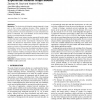1348 search results - page 81 / 270 » From Informatics to Bioinformatics |
BIOINFORMATICS
2010
13 years 7 months ago
2010
Phylogenetic trees are widely used to display estimates of how groups of species evolved. Each phylogenetic tree can be seen as a collection of clusters, subgroups of the species ...
BIOINFORMATICS
2010
13 years 7 months ago
2010
Motivation: Existing methods for protein sequence analysis are generally firstorder and inherently assume that each position is independent. We develop a general framework for int...
BIOINFORMATICS
2007
13 years 7 months ago
2007
Horizontal gene transfer (HGT) is believed to be ubiquitous among bacteria, and plays a major role in their genome diversification as well as their ability to develop resistance t...
BIOINFORMATICS
2007
13 years 7 months ago
2007
Motivation: The functioning of biological networks depends in large part on their complex underlying structure. When studying their systemic nature many modeling approaches focus ...
BIOINFORMATICS
2011
12 years 11 months ago
2011
Abstract. This document is a preprint of the following publication: Bioinformatics (2011) 27(8): 1166-1167. Algorithms for sparse data require fast search and subset selection capa...

